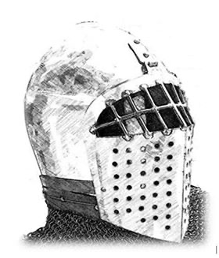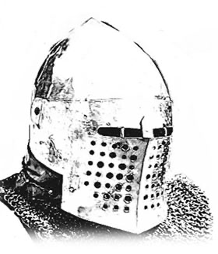Armored Steel Combat:Armor Standards
Armor Standards
General
- The construction of armor shall explicitly meet the standards as outlined below.
- The minimum armor standards are designed to allow for recommended protection; combatants are encouraged to armor to the level they feel safe beyond the minimum standards.
- The protective equipment has to provide reliable protection to the head, neck, spine and joints in any body position.
Helm


- Helms shall be of welded or riveted construction with a minimum of 12-gauge mild steel thickness or equivalent protection from other materials (i.e. stainless steel or spring steel).
- Helms shall have no internal protrusions which could cause injury to the wearer.
- Helms shall be padded in such a manner as to provide progressive give under the force of a blow without resulting in injury to the wearer. Foam/padding and a suspension system are two examples.
- Helms shall have a chin strap, which ensures its stability, eliminating any possibility that it may fall off or come loose during combat.
- Helms shall not have an opening in excess of the following:
- For grill style openings, the maximum shall be 3/4 inch by 1 1/2 inch or have an open area not to exceed 1.125 square inches.
- For horizonal oculariums (historical style) openings, the maximum shall be 1/2 inch by 2 1/4 inch or have an open area not to exceed 1.125 square inches.
- Combatants may use shatter proof glasses (Meet ANSI Z87.1-2003 high-impact standards) where the helm does not meet the requirements for these openings at the discretion of the inspecting marshal.
- If a visor is used it shall be held in place by a positive system that does not allow it to become open or dislodged during combat.
Neck Armor
- Cervical vertebra shall be protected by rigid material with padding under it.
- Note: an aventail, camail, or equivalent alone may be insufficient based on the fit of the helm. Combatants are cautioned that additional protection may be required.
Torso
The torso shall be covered by rigid material and padding. The chest, sides and back (including the spine) shall be covered with rigid material.
Hips
The point of the iliac crest (i.e. top of the hip bone) needs to be covered by rigid material.
Groin
The groin shall be protected by gender-specific, appropriately constructed rigid material. Due to the nature of groin protection, the commonly produced mundane protectors are recommended.
Shoulders
The shoulders shall be protected by rigid material, including the collar bones and the shoulder joints.
Forearm
The forearm shall be protected with rigid material (i.e. the use of a vambrace) along the radius and ulna bones from where the elbow cop ends and where the gauntlet begins. Padding is also required.
Hands
The hands shall be protected by rigid, mitten style gauntlets. Gauntlets shall completely cover the hand and the cuff of the gauntlet shall extend a minimum of one inch above the condyle of the wrist.
- Fingered gauntlets are prohibited without the use of supplemental protection, i.e. hand shields or baskets.
- A shield would meet the requirements for that hand protection.
Elbow and Knee
- The elbow and knee shall be protected with rigid material.
- The armor shall be constructed in such a fashion that the metal cannot contact the joint under force of blow.
- The three points of the joint must be protected.
Thighs and Shins
Thighs and shins shall be protected with rigid material.
Foot
- Shoes or boots which cover and protect the entire foot are required.
- Sneakers and cleats are prohibited.
- Combatants should wear footwear that provides adequate protection and support for the terrain and activity of combat.
Upper Arm
- Rerebraces (armor for the upper part of the arm) are not required, but strongly recommended.
- Cut resistant material is required. An arming coat or gambeson would meet this requirement.
Appearance
There shall be a 10-foot appearance rule in effect. The means that the combatant shall not have visible mundane equipment from 10 feet.
Definitions
- Rigid
- Rigid is defined as a single or combination of materials which provide stiff and unyielding protection from the impact of the weapons being used (i.e. no injury resulting from being struck from the weapons where the armor and weapon were used as intended.)
- Padding
- Padding can be in the form of a gambeson or modern materials.